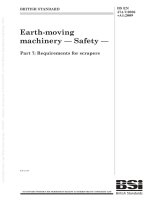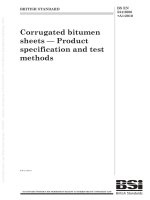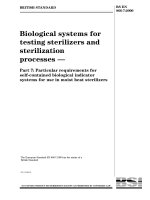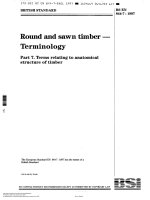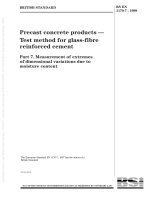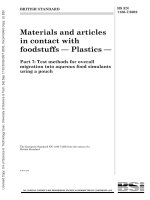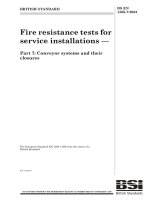Bsi bs en 61850 7 2 2010
Bạn đang xem bản rút gọn của tài liệu. Xem và tải ngay bản đầy đủ của tài liệu tại đây (2.88 MB, 220 trang )
BS EN 61850-7-2:2010
BSI Standards Publication
Communication networks
and systems for power
utility automation
Part 7-2: Basic information and communication
structure — Abstract communication service
interface (ACSI)
NO COPYING WITHOUT BSI PERMISSION EXCEPT AS PERMITTED BY COPYRIGHT LAW
raising standards worldwide™
BRITISH STANDARD
BS EN 61850-7-2:2010
National foreword
This British Standard is the UK implementation of EN 61850-7-2:2010. It is
identical to IEC 61850-7-2:2010. It supersedes BS EN 61850-7-2:2003, which
is withdrawn.
The UK participation in its preparation was entrusted to Technical Committee
PEL/57, Power systems management and associated information exchange.
A list of organizations represented on this committee can be obtained on
request to its secretary.
This publication does not purport to include all the necessary provisions of a
contract. Users are responsible for its correct application.
© BSI 2010
ISBN 978 0 580 52972 6
ICS 33.200
Compliance with a British Standard cannot confer immunity from
legal obligations.
This British Standard was published under the authority of the
Standards Policy and Strategy Committee on 31 January 2011.
Amendments/corrigenda issued since publication
Date
Text affected
BS EN 61850-7-2:2010
EUROPEAN STANDARD
EN 61850-7-2
NORME EUROPÉENNE
October 2010
EUROPÄISCHE NORM
ICS 33.200
Supersedes EN 61850-7-2:2003
English version
Communication networks and systems for power utility automation Part 7-2: Basic information and communication structure Abstract communication service interface (ACSI)
(IEC 61850-7-2:2010)
Réseaux de communication pour
l'automatisation des systèmes des
compagnies d’électricité Partie 7-2: Principes des structures
d’informations et de communication Interface de services abstraits de
communication (ACSI)
(CEI 61850-7-2:2010)
Kommunikationsnetze und -systeme für
die Automatisierung in der elektrischen
Energieversorgung Teil 7-2: Grundlegende Informations- und
Kommunikationsstruktur Abstrakte Schnittstelle für
Kommunikationsdienste (ACSI)
(IEC 61850-7-2:2010)
This European Standard was approved by CENELEC on 2010-10-01. CENELEC members are bound to comply
with the CEN/CENELEC Internal Regulations which stipulate the conditions for giving this European Standard
the status of a national standard without any alteration.
Up-to-date lists and bibliographical references concerning such national standards may be obtained on
application to the Central Secretariat or to any CENELEC member.
This European Standard exists in three official versions (English, French, German). A version in any other
language made by translation under the responsibility of a CENELEC member into its own language and notified
to the Central Secretariat has the same status as the official versions.
CENELEC members are the national electrotechnical committees of Austria, Belgium, Bulgaria, Croatia, Cyprus,
the Czech Republic, Denmark, Estonia, Finland, France, Germany, Greece, Hungary, Iceland, Ireland, Italy,
Latvia, Lithuania, Luxembourg, Malta, the Netherlands, Norway, Poland, Portugal, Romania, Slovakia, Slovenia,
Spain, Sweden, Switzerland and the United Kingdom.
CENELEC
European Committee for Electrotechnical Standardization
Comité Européen de Normalisation Electrotechnique
Europäisches Komitee für Elektrotechnische Normung
Management Centre: Avenue Marnix 17, B - 1000 Brussels
© 2010 CENELEC -
All rights of exploitation in any form and by any means reserved worldwide for CENELEC members.
Ref. No. EN 61850-7-2:2010 E
BS EN 61850-7-2:2010
EN 61850-7-2:2010
Foreword
The text of document 57/1065/FDIS, future edition 2 of IEC 61850-7-2, prepared by IEC TC 57, Power
systems management and associated information exchange, was submitted to the IEC-CENELEC
parallel vote and was approved by CENELEC as EN 61850-7-2 on 2010-10-01.
This European Standard supersedes EN 61850-7-2:2003.
The major technical changes with regard to EN 61850-7-2:2003 are as follows:
– class diagrams have been updated;
– data types not required have been removed;
– errors and typos haven been corrected;
– substitution model has been moved to EN 61850-7-3;
– service tracking for control blocks have been added;
– the view concept will be according to the new work on role bases access (RBA);
– security issues are solved by the IEC 62351 series; and
– several terms have been harmonized with those in the other parts.
This publication has been drafted in accordance with the ISO/IEC Directives, Part 2.
In this document, the following print types are used:
– bold is used to highlight defined terms;
– Tahoma is used where the difference between a capital i (I) and a small L (l) is important to see.
Attention is drawn to the possibility that some of the elements of this document may be the subject of
patent rights. CEN and CENELEC shall not be held responsible for identifying any or all such patent
rights.
The following dates were fixed:
– latest date by which the EN has to be implemented
at national level by publication of an identical
national standard or by endorsement
(dop)
2011-07-01
– latest date by which the national standards conflicting
with the EN have to be withdrawn
(dow)
2013-10-01
Annex ZA has been added by CENELEC.
__________
Endorsement notice
The text of the International Standard IEC 61850-7-2:2010 was approved by CENELEC as a European
Standard without any modification.
In the official version, for Bibliography, the following notes have to be added for the standards indicated:
IEC 61400-25-2
NOTE Harmonized as EN 61400-25-2.
IEC 61850-8 series
NOTE Harmonized in EN 61850-8 series (not modified).
IEC 61850-9 series
NOTE Harmonized in EN 61850-9 series (not modified).
BS EN 61850-7-2:2010
EN 61850-7-2:2010
IEC 61850-9-1
NOTE Harmonized as EN 61850-9-1.
__________
BS EN 61850-7-2:2010
EN 61850-7-2:2010
Annex ZA
(normative)
Normative references to international publications
with their corresponding European publications
The following referenced documents are indispensable for the application of this document. For dated
references, only the edition cited applies. For undated references, the latest edition of the referenced
document (including any amendments) applies.
NOTE When an international publication has been modified by common modifications, indicated by (mod), the relevant EN/HD
applies.
Publication
Year
Title
EN/HD
Year
IEC/TS 61850-2
-
Communication networks and systems in
substations Part 2: Glossary
-
-
IEC 61850-5
-
Communication networks and systems in
substations Part 5: Communication requirements for
functions and device models
EN 61850-5
-
IEC 61850-6
-
EN 61850-6
Communication networks and systems for
power utility automation Part 6: Configuration description language for
communication in electrical substations
related to IEDs
-
IEC 61850-7-1
-
EN 61850-7-1
Communication networks and systems in
substations Part 7-1: Basic communication structure for
substation and feeder equipment - Principles
and models
-
IEC 61850-7-3
-
Communication networks and systems in
substations Part 7-3: Basic communication structure for
substation and feeder equipment - Common
data classes
EN 61850-7-3
-
IEC 61850-7-4
-
Communication networks and systems for
power utility automation Part 7-4: Basic communication structure Compatible logical node classes and data
object classes
EN 61850-7-4
-
IEC 61850-8-1
-
EN 61850-8-1
Communication networks and systems in
substations Part 8-1: Specific Communication Service
Mapping (SCSM) - Mappings to MMS
(ISO 9506-1 and ISO 9506-2) and to ISO/IEC
8802-3
-
IEC 61850-9-2
-
Communication networks and systems in
substations Part 9-2: Specific Communication Service
Mapping (SCSM) - Sampled values over
ISO/IEC 8802-3
EN 61850-9-2
-
BS EN 61850-7-2:2010
EN 61850-7-2:2010
Publication
Year
Title
EN/HD
Year
ISO 4217
-
Codes for the representation of currencies
and funds
-
-
ISO 9506-1
-
Industrial automation systems Manufacturing Message Specification Part 1: Service definition
-
-
IEEE 754
-
Binary floating-point arithmetic
-
-
BS EN 61850-7-2:2010
61850-7-2 © IEC:2010(E)
CONTENTS
INTRODUCTION ................................................................................................................... 11
1
Scope ............................................................................................................................. 12
2
Normative references...................................................................................................... 12
3
Terms and definitions ..................................................................................................... 13
4
Abbreviated terms........................................................................................................... 14
5
ACSI overview and basic concepts .................................................................................. 15
5.1
5.2
5.3
6
Conceptual model of IEC 61850 ............................................................................. 15
The meta-meta model............................................................................................ 16
The meta model..................................................................................................... 16
5.3.1 General ..................................................................................................... 16
5.3.2 Information modelling classes .................................................................... 17
5.3.3 Information exchange modelling classes .................................................... 18
5.3.4 Relations between classes ......................................................................... 20
5.4 The domain type model.......................................................................................... 21
5.5 The data instance model........................................................................................ 21
TypeDefinitions ............................................................................................................... 22
6.1
7
General ................................................................................................................. 22
6.1.1 BasicTypes ................................................................................................ 22
6.1.2 CommonACSITypes................................................................................... 23
GenServerClass model ................................................................................................... 29
7.1
8
GenServerClass definition ..................................................................................... 29
7.1.1 GenServerClass syntax.............................................................................. 29
7.1.2 GenServerClass attributes ......................................................................... 30
7.2 Server class services ............................................................................................. 30
7.2.1 Overview of directory and GetDefinition services ........................................ 30
7.2.2 GetServerDirectory .................................................................................... 31
Application association model ......................................................................................... 32
8.1
8.2
8.3
9
Introduction ........................................................................................................... 32
Concept of application associations ....................................................................... 32
TWO-PARTY-APPLICATION-ASSOCIATION (TPAA) class model.......................... 32
8.3.1 TWO-PARTY-APPLICATION-ASSOCIATION (TPAA) class definition ......... 32
8.3.2 Two-party application association services ................................................. 34
8.4 MULTICAST-APPLICATION-ASSOCIATION (MCAA) class .................................... 37
8.4.1 MULTICAST-APPLICATION-ASSOCIATION (MCAA) class definition.......... 37
8.4.2 MULTICAST-Application-association (MCAA) class attributes ..................... 37
GenLogicalDeviceClass model ........................................................................................ 38
9.1
GenLogicalDeviceClass definition .......................................................................... 38
9.1.1 GenLogicalDeviceClass syntax .................................................................. 38
9.1.2 GenLogicalDeviceClass attributes .............................................................. 38
9.2 GenLogicalDeviceClass services.......................................................................... 38
9.2.1 GetLogicalDeviceDirectory ......................................................................... 38
10 GenLogicalNodeClass model .......................................................................................... 39
10.1 GenLogicalNodeClass definition............................................................................. 39
10.1.1 GenLogicalNodeClass diagram .................................................................. 39
10.1.2 GenLogicalNodeClass syntax ..................................................................... 40
BS EN 61850-7-2:2010
61850-7-2 © IEC:2010(E)
10.1.3 GenLogicalNodeClass attributes ................................................................ 41
10.2 GenLogicalNodeClass services .............................................................................. 42
10.2.1 Overview ................................................................................................... 42
10.2.2 GetLogicalNodeDirectory ........................................................................... 42
10.2.3 GetAllDataValues....................................................................................... 43
11 Generic data object class model ..................................................................................... 45
11.1 GenDataObjectClass diagram ................................................................................ 45
11.2 GenDataObjectClass syntax .................................................................................. 45
11.3 GenDataObjectClass attributes .............................................................................. 46
11.3.1 DataObjectName ....................................................................................... 46
11.3.2 DataObjectRef – data object reference....................................................... 46
11.3.3 m/o/c ......................................................................................................... 46
11.3.4 DataObjectType ......................................................................................... 46
11.4 GenDataObjectClass services................................................................................ 46
11.4.1 General definitions and overview................................................................ 46
11.4.2 GetDataValues .......................................................................................... 47
11.4.3 SetDataValues ........................................................................................... 48
11.4.4 GetDataDirectory ....................................................................................... 49
11.4.5 GetDataDefinition ...................................................................................... 50
12 Generic common data class model.................................................................................. 50
12.1 General ................................................................................................................. 50
12.2 GenCommonDataClass ......................................................................................... 51
12.2.1 GenCommonDataClass diagram ................................................................ 51
12.2.2 GenCommonDataClass syntax ................................................................... 51
12.2.3 GenCommonDataClass attributes .............................................................. 52
12.3 GenDataAttributeClass .......................................................................................... 52
12.3.1 GenDataAttributeClass diagram ................................................................. 52
12.3.2 GenDataAttributeClass syntax.................................................................... 53
12.3.3 GenDataAttributeClass attributes ............................................................... 53
12.4 GenConstructedAttributeClass ............................................................................... 57
12.4.1 GenConstructedAttributeClass diagram ...................................................... 57
12.4.2 GenConstructedAttributeClass syntax ........................................................ 57
12.4.3 GenConstructedAttributeClass attributes ..................................................... 57
12.5 GenSubDataAttributeClass .................................................................................... 57
12.5.1 SubDataAttributeClass diagram ................................................................. 57
12.5.2 SubDataAttributeClass syntax .................................................................... 58
12.5.3 GenSubDataAttributeClass attributes ......................................................... 58
12.6 Referencing data objects and their components ..................................................... 58
12.6.1 General ..................................................................................................... 58
12.6.2 Reference syntax ....................................................................................... 59
12.6.3 Base types and their relation ...................................................................... 59
12.6.4 Example of using references ...................................................................... 60
13 DATA-SET class model .................................................................................................. 61
13.1 General ................................................................................................................. 61
13.2 DATA-SET class definition ..................................................................................... 62
13.2.1 DATA-SET class syntax ............................................................................. 62
13.2.2 DATA-SET class attributes......................................................................... 63
13.3 DATA-SET class services ...................................................................................... 63
13.3.1 Overview ................................................................................................... 63
BS EN 61850-7-2:2010
61850-7-2 © IEC:2010(E)
13.3.2 GetDataSetValues ..................................................................................... 64
13.3.3 SetDataSetValues...................................................................................... 65
13.3.4 CreateDataSet ........................................................................................... 66
13.3.5 DeleteDataSet ........................................................................................... 66
13.3.6 GetDataSetDirectory .................................................................................. 67
14 Service tracking .............................................................................................................. 68
14.1 General ................................................................................................................. 68
14.2 Common service tracking (CST) ............................................................................ 68
15 Modelling of control block classes ................................................................................... 70
15.1 General ................................................................................................................. 70
15.2 Control block class models .................................................................................... 70
15.2.1 Control block attributes .............................................................................. 71
15.2.2 Control block services ................................................................................ 71
15.2.3 Attribute type ............................................................................................. 71
15.3 Control block tracking services .............................................................................. 71
15.3.1 General ..................................................................................................... 71
15.3.2 Common data classes for control block service tracking ............................. 72
16 SETTING-GROUP-CONTROL-BLOCK class model ......................................................... 82
16.1 General ................................................................................................................. 82
16.2 SGCB class definition ............................................................................................ 83
16.2.1 SGCB class syntax .................................................................................... 83
16.2.2 SGCB class attributes ................................................................................ 84
16.3 SGCB class services ............................................................................................. 85
16.3.1 Overview ................................................................................................... 85
16.3.2 SelectActiveSG .......................................................................................... 85
16.3.3 SelectEditSG ............................................................................................. 86
16.3.4 SetEditSGValue ......................................................................................... 87
16.3.5 ConfirmEditSGValues ................................................................................ 88
16.3.6 GetEditSGValue......................................................................................... 89
16.3.7 GetSGCBValues ........................................................................................ 90
17 REPORT-CONTROL-BLOCK and LOG-CONTROL-BLOCK class models ........................ 91
17.1 Overview ............................................................................................................... 91
17.2 REPORT-CONTROL-BLOCK class model.............................................................. 93
17.2.1 Basic concepts .......................................................................................... 93
17.2.2 BUFFERED-REPORT-CONTROL-BLOCK (BRCB) class definition ............. 93
17.2.3 BRCB class services................................................................................ 103
17.2.4 UNBUFFERED-REPORT-CONTROL-BLOCK (URCB) class definition ...... 116
17.2.5 URCB class services ............................................................................... 117
17.3 LOG-CONTROL-BLOCK class model ................................................................... 118
17.3.1 General ................................................................................................... 118
17.3.2 LCB class definition ................................................................................. 119
17.3.3 LOG class definition................................................................................. 124
17.3.4 Reason code for log entries ..................................................................... 127
17.3.5 LOG services ........................................................................................... 127
18 Generic substation event class model (GSE) ................................................................. 131
18.1 Overview ............................................................................................................. 131
18.2 GOOSE-CONTROL-BLOCK (GoCB) class ........................................................... 132
18.2.1 GoCB definition ....................................................................................... 132
18.2.2 GOOSE service definitions....................................................................... 134
BS EN 61850-7-2:2010
61850-7-2 © IEC:2010(E)
18.2.3 Generic object oriented substation event (GOOSE) message ................... 139
19 Transmission of sampled value class model .................................................................. 140
19.1 Overview ............................................................................................................. 140
19.2 Transmission of sampled values using multicast .................................................. 142
19.2.1 MSVCB class definition ............................................................................ 142
19.2.2 Multicast sampled value class services .................................................... 144
19.3 Transmission of sampled values using unicast ..................................................... 147
19.3.1 USVCB class definition ............................................................................ 147
19.3.2 Unicast sampled value services ............................................................... 150
19.4 Sampled value format .......................................................................................... 153
19.4.1 MsvID or UsvID ..................................................................................... 154
19.4.2 OptFlds ................................................................................................. 154
19.4.3 DatSet ................................................................................................... 154
19.4.4 Sample [1..n] ......................................................................................... 155
19.4.5 SmpCnt ................................................................................................. 155
19.4.6 RefrTm .................................................................................................. 155
19.4.7 ConfRev ................................................................................................ 155
19.4.8 SmpSynch ............................................................................................. 155
19.4.9 SmpRate ............................................................................................... 155
19.4.10 SmpMod ................................................................................................ 155
19.4.11 Simulation ............................................................................................. 155
20 CONTROL class model ................................................................................................. 156
20.1 Introduction ......................................................................................................... 156
20.2 Control with normal security ................................................................................. 158
20.2.1 Direct control with normal security............................................................ 158
20.2.2 SBO control with normal security.............................................................. 160
20.3 Control with enhanced security ............................................................................ 162
20.3.1 Introduction ............................................................................................. 162
20.3.2 Direct control with enhanced security ....................................................... 162
20.3.3 SBO control with enhanced security ......................................................... 163
20.4 Time-activated operate ........................................................................................ 166
20.5 CONTROL class service definitions ..................................................................... 167
20.5.1 Overview ................................................................................................. 167
20.5.2 Service parameter definition..................................................................... 168
20.5.3 Service specification ................................................................................ 172
20.6 Tracking of control services ................................................................................. 178
20.6.1 General ................................................................................................... 178
20.6.2 Control service tracking (CTS) ................................................................. 178
21 Time and time-synchronization model ........................................................................... 179
21.1 General ............................................................................................................... 179
21.2 External information............................................................................................. 180
22 Naming conventions ..................................................................................................... 181
22.1 Class naming and class specializations................................................................ 181
22.2 Referencing an instance of a class....................................................................... 182
22.3 Scope.................................................................................................................. 183
23 File transfer model ........................................................................................................ 184
23.1 File class ............................................................................................................. 184
23.1.1 FileName ................................................................................................. 184
23.1.2 FileSize ................................................................................................... 184
BS EN 61850-7-2:2010
61850-7-2 © IEC:2010(E)
23.1.3 LastModified ............................................................................................ 184
23.2 File services ........................................................................................................ 185
23.2.1 GetFile .................................................................................................... 185
23.2.2 SetFile ..................................................................................................... 185
23.2.3 DeleteFile ................................................................................................ 186
23.2.4 GetFileAttributeValues ............................................................................. 186
Annex A (normative) ACSI conformance statement............................................................. 188
Annex B (normative) Formal definition of IEC 61850-7-2 Common Data Classes................. 195
Annex C (informative) Generic substation state event (GSSE) control block (GsCB) ........... 203
Bibliography ........................................................................................................................ 212
Index .................................................................................................................................. 213
Figure 1 – Excerpt of conceptual model of IEC 61850 ............................................................ 16
Figure 2 – Basic conceptual class model of the ACSI............................................................. 17
Figure 3 – Conceptual service model of the ACSI .................................................................. 19
Figure 4 – Core of the conceptual meta model and relationship ............................................. 21
Figure 5 – Data instance model (conceptual) ......................................................................... 22
Figure 6 – Overview about GetDirectory and GetDefinition services ....................................... 30
Figure 7 – Normal operation .................................................................................................. 33
Figure 8 – Aborting association ............................................................................................. 33
Figure 9 – Principle of multicast application association ......................................................... 37
Figure 10 – Basic conceptual model of the GenLogicalNodeClass.......................................... 40
Figure 11 – Basic conceptual class model of the GenDataObjectClass .................................. 45
Figure 12 – Excerpt of GenDataObjectClass services ............................................................ 47
Figure 13 – Class diagram of the GenCommonDataClass ...................................................... 51
Figure 14 – Conceptual Class diagram of the GenCommonDataClass.................................... 51
Figure 15 – Class diagram of the GenDataAttributeClass ....................................................... 52
Figure 16 – Relation of TrgOp and Reporting......................................................................... 56
Figure 17 – Class diagram of the GenConstructedAttributeClass ........................................... 57
Figure 18 – Relation of types (example) ................................................................................ 60
Figure 19 – Example of a data object .................................................................................... 61
Figure 20 – Dynamic creation of data set instances ............................................................... 62
Figure 21 – Control block service mapping ............................................................................ 72
Figure 22 – Basic model of the settings model ....................................................................... 83
Figure 23 – Basic building blocks for reporting and logging .................................................... 92
Figure 24 – BRCB state machine........................................................................................... 95
Figure 25 – General queue of entries for report handler ......................................................... 96
Figure 26 – Buffer time.......................................................................................................... 98
Figure 27 – State Machine for Sequence Number Generation ................................................ 99
Figure 28 – Logical state machine for general interrogation ................................................. 101
Figure 29 – Report example on the use of sequence number ............................................... 105
Figure 30 – Entry discard that does not cause indication of loss of information in
enabled state ...................................................................................................................... 106
Figure 31 – Indication of loss of information due to resource constraints in enable state ...... 107
BS EN 61850-7-2:2010
61850-7-2 © IEC:2010(E)
Figure 32 – Data set members and reporting ....................................................................... 108
Figure 33 – Report example ................................................................................................ 109
Figure 34 – Log model overview .......................................................................................... 119
Figure 35 – GoCB model ...................................................................................................... 131
Figure 36 – Model for transmission of sampled values ......................................................... 141
Figure 37 – Principle of the control model ............................................................................ 156
Figure 38 – State machine of direct control with normal security .......................................... 159
Figure 39 – Direct control with normal security..................................................................... 160
Figure 40 – State machine of SBO control with normal security............................................ 161
Figure 41 – State machine of direct control with enhanced security ...................................... 163
Figure 42 – State machine SBO control with enhanced security ........................................... 164
Figure 43 – Select before operate with enhanced security – positive case ............................ 165
Figure 44 – Select before operate with enhanced security – negative case (no status
change) .............................................................................................................................. 165
Figure 45 – Time-activated operate ..................................................................................... 167
Figure 46 – Time model and time synchronization (principle) ............................................... 180
Figure 47 – Specializations.................................................................................................. 181
Figure 48 – Object names and object reference ................................................................... 183
Figure C.1 – GsCB model..................................................................................................... 203
Table 1 – ACSI model classes with related services .............................................................. 20
Table 2 – BasicTypes ............................................................................................................ 23
Table 3 – ObjectName type ................................................................................................... 24
Table 4 – ObjectReference type ............................................................................................ 24
Table 5 – ServiceError type ................................................................................................... 25
Table 6 – PACKED-LIST type ................................................................................................ 26
Table 7 – TimeStamp type..................................................................................................... 26
Table 8 – TimeQuality definition ............................................................................................ 27
Table 9 – TimeAccuracy........................................................................................................ 28
Table 10 – TriggerConditions type ......................................................................................... 28
Table 11 – ReasonForInclusion ............................................................................................. 29
Table 12 – GenServerClass definition.................................................................................... 29
Table 13 – TWO-PARTY-APPLICATION-ASSOCIATION (TPAA) class definition ................... 33
Table 14 – MULTICAST-APPLICATION-ASSOCIATION (MCAA) class definition.................... 37
Table 15 – GenLogicalDeviceClass (GenLD) class definition ................................................. 38
Table 16 – GenLogicalNodeClass definition ........................................................................... 40
Table 17 – GenDataObjectClass definition............................................................................. 46
Table 18 – GenCommonDataClass definition........................................................................... 52
Table 19 – GenDataAttributeClass definition .......................................................................... 53
Table 20 – Functional constraint values ................................................................................. 54
Table 21 – TrgOp .................................................................................................................. 56
Table 22 – GenConstructedAttributeClass definition................................................................ 57
Table 23 – GenSubDataAttributeClass definition .................................................................... 58
BS EN 61850-7-2:2010
61850-7-2 © IEC:2010(E)
Table 24 – DATA-SET (DS) class definition ........................................................................... 63
Table 25 – Common service tracking common data class (CST) definition ............................. 69
Table 26 – ServiceType type ................................................................................................. 70
Table 27 – CB class definition ............................................................................................... 71
Table 28 – Buffered report tracking service (BTS) definition................................................... 73
Table 29 – Unbuffered report tracking service (UTS) definition .............................................. 74
Table 30 – Log control block tracking service (LTS) definition ................................................ 76
Table 31 – Log tracking service (OTS) definition.................................................................... 77
Table 32 – GOOSE Control block tracking service (GTS) definition ........................................ 78
Table 33 – MSVCB tracking service (MTS) definition ............................................................. 79
Table 34 – USVCB tracking service (NTS) definition .............................................................. 80
Table 35 – SGCB tracking service (STS) definition ................................................................ 81
Table 36 – SGCB class definition .......................................................................................... 84
Table 37 – BRCB class definition .......................................................................................... 94
Table 38 – Report format specification ................................................................................ 104
Table 39 – URCB class definition ........................................................................................ 116
Table 40 – LCB class definition ........................................................................................... 120
Table 41 – LOG class definition........................................................................................... 125
Table 42 – GOOSE control block class definition ................................................................. 132
Table 43 – GOOSE message definition................................................................................ 139
Table 44 – MSVCB class definition ...................................................................................... 142
Table 45 – USVCB class definition ...................................................................................... 148
Table 46 – Sampled value (SV) format definition ................................................................. 154
Table 47 – Generic behavior and negative responses .......................................................... 157
Table 48 – Control services ................................................................................................. 167
Table 49 – T definition......................................................................................................... 168
Table 50 – Test definition .................................................................................................... 169
Table 51 – Check condition definition .................................................................................. 169
Table 52 – operTm definition ............................................................................................... 169
Table 53 – Additional cause diagnosis definition .................................................................. 170
Table 54 – AddCause semantic ........................................................................................... 171
Table 55 – Control service tracking (CTS) definition ............................................................ 179
Table 56 – FILE class definition........................................................................................... 184
Table A.1 – Basic conformance statement ........................................................................... 189
Table A.2 – ACSI models conformance statement ............................................................... 190
Table A.3 – ACSI service conformance statement ............................................................... 191
Table C.1 – GSSE control block class definition .................................................................. 204
Table C.2 – GSSE message definition ................................................................................. 210
BS EN 61850-7-2:2010
61850-7-2 © IEC:2010(E)
– 11 –
INTRODUCTION
This document is part of a set of definitions which details a layered utility communication
architecture. This architecture has been chosen to provide abstract definitions of classes and
services such that the definitions are independent of specific protocol stacks, implementations,
and operating systems.
The IEC 61850 series is intended to provide interoperability between a variety of devices.
Communication between these devices is achieved by the definition of a hierarchical class
model (for example, logical device, logical node, data, data set, report control, or log) and
services provided by these classes (for example, get, set, report, define, delete) in IEC 618507-x.
This part of IEC 61850 defines the abstract communication service interface (ACSI) for use in
the utility application domain that requires real-time cooperation of intelligent electronic
devices. The ACSI has been defined so as to be independent of the underlying communication
systems. Specific communication service mappings 1) (SCSM) are specified in IEC 61850-8-x
and IEC 61850-9-x.
This part of IEC 61850 defines the abstract communication service interface in terms of
–
a hierarchical class model of all information that can be accessed via a communication
network,
–
services that operate on these classes, and
–
parameters associated with each service.
The ACSI description technique abstracts away from all the different approaches to implement
the cooperation of the various devices.
NOTE 1 Abstraction in ACSI has two meanings. First, only those aspects of a real device (for example, a breaker)
or a real function that are visible and accessible over a communication network are modelled. This abstraction
leads to the hierarchical class models and their behaviour defined in IEC 61850-7-2, IEC 61850-7-3, and
IEC 61850-7-4. Second, the ACSI abstracts from the aspect of concrete definitions on how the devices exchange
information; only a conceptual cooperation is defined. The concrete information exchange is defined in the SCSMs.
NOTE 2 This part of IEC 61850 does not provide comprehensive tutorial material. It is recommended that
IEC 61850-5 and IEC 61850-7-1 be read first in conjunction with IEC 61850-7-2 and IEC 61850-7-3.
NOTE 3 Examples use names of classes (for example XCBR for a class of a logical node) defined in
IEC 61850-7-4 and IEC 61850-7-3. The normative names are defined in IEC 61850-7-4 and IEC 61850-7-3 only.
———————
1) The ACSI is independent of the specific mapping. Mappings to standard application layers or middle ware
technologies are possible.
BS EN 61850-7-2:2010
– 12 –
61850-7-2 © IEC:2010(E)
COMMUNICATION NETWORKS AND SYSTEMS
FOR POWER UTILITY AUTOMATION –
Part 7-2: Basic information and communication structure –
Abstract communication service interface (ACSI)
1
Scope
This part of IEC 61850 applies to the ACSI communication for utility automation. The ACSI
provides the following abstract communication service interfaces.
a) Abstract interface describing communications between a client and a remote server for
–
real-time data access and retrieval,
–
device control,
–
event reporting and logging,
–
setting group control,
–
self-description of devices (device data dictionary),
–
data typing and discovery of data types, and
–
file transfer.
b) Abstract interface for fast and reliable system-wide event distribution between an application in one device and many remote applications in different devices (publisher/sub-scriber)
and for transmission of sampled measured values (publisher/subscriber).
2
Normative references
The following referenced documents are indispensable for the application of this document. For
dated references, only the edition cited applies. For undated references, the latest edition of
the referenced document (including any amendments) applies.
IEC 61850-2, Communication networks and systems in substations – Part 2: Glossary
IEC 61850-5, Communication networks and systems in substations – Part 5: Communication
requirements for functions and devices models
IEC 61850-6, Communication networks and systems for power utility automation – Part 5:
Configuration description language for communication in electrical substations related to IEDs
IEC 61850-7-1, Communication networks and systems for power utility automation – Part 7-1:
Basic communication structure – Principles and models 2)
IEC 61850-7-3, Communication networks and systems for power utility automation – Part 7-3:
Basic communication structure – Common data classes 2)
IEC 61850-7-4, Communication networks and systems for power utility automation – Part 7-4:
Basic communication structure – Compatible logical node classes and data object classes
———————
2) To be published.
BS EN 61850-7-2:2010
61850-7-2 © IEC:2010(E)
– 13 –
IEC 61850-8-1, Communication networks and systems for power utility automation – Part 8-1:
Specific communication service mapping (SCSM) – Mappings to MMS (ISO 9506-1 and
ISO 9506-2) and to ISO/IEC 8802-3 3)
IEC 61850-9-2, Communication networks and systems for power utility automation – Part 9-2:
Specific communication service mapping (SCSM) – Sampled values over ISO/IEC 8802-33)
ISO 4217, Codes for the representation of currencies and funds
ISO 9506 (all parts), Industrial automation systems – Manufacturing Message Specification
IEEE 754, Standard for Floating-Point Arithmetic
3
Terms and definitions
For the purposes of this document, the terms and definitions provided in IEC 61850-2 and the
following apply.
3.1
class
description of a set of objects that share the same attributes, services, relationships, and
semantics
3.2
client
entity that requests a service from a server and that receives unsolicited messages from
a server
3.3
device
entity that performs control, actuating and/or sensing functions and interfaces to other such
entities within an automation system
NOTE
Devices alone do not perform energy generation, transport, or distribution functions.
3.4
external equipment
entity that is stand-alone, or interfaces to an automation system, and that performs energy
generation, transport, or distribution functions
EXAMPLE
NOTE 1
Transformer, circuit-breaker, line.
Equipment can contain devices.
NOTE 2 Equipment cannot have a direct connection to the communication network – only devices can be directly
connected to the communication network.
3.5
instance (of a class)
entity that has unique identity, to which a set of services can be applied, and which has a state
that stores the effects of the services
NOTE
Instance is a synonym for the term object.
———————
3) To be published.
BS EN 61850-7-2:2010
– 14 –
61850-7-2 © IEC:2010(E)
3.6
logical device
entity that represents a set of typical automation, protection or other functions
3.7
logical node
entity that represents a typical automation, protection or other function
3.8
physical device
entity that represents the physical parts of a device (hardware and operating system, etc.)
NOTE
4
Physical devices host logical devices.
Abbreviated terms
AA
application association
ACSI
abstract communication service interface
BRCB
buffered report control block
CB
control block
CDC
common data class (IEC 61850-7-3)
CT
current transformer
DA
data attribute
DataRef
data reference
dchg
data change trigger option
DS
data set
dupd
data-update trigger option
FC
functional constraint
FCD
functional constrained data
FCDA
functional constrained data attribute
GI
general interrogation
GoCB
GOOSE control block
GOOSE
generic object oriented substation events
GSE
generic substation event
GsCB
GSSE control block
GSSE
generic substation status event
IED
intelligent electronic device
IntgPd
integrity period
LCB
log control block
LD
logical device (in this part of IEC 61850, the generic logical device class
is defined (genLogicalDevice)
LN
logical node (in this part of IEC 61850, the generic logical node class is
defined (genLogicalNode)
MC
multicast
MCAA
multicast application association
MMS
manufacturing message specification (ISO 9506)
BS EN 61850-7-2:2010
61850-7-2 © IEC:2010(E)
– 15 –
MSVCB
multicast sampled value control block
PDU
protocol data unit
PICS
protocol implementation conformance statement
PIXIT
protocol Implementation extra information
qchg
quality change trigger option
SBO
select before operate
SCL
substation configuration language (IEC 61850-6)
SCSM
specific communication service mapping
(defined in IEC 61850-8-x and IEC 61850-9-x)
SGCB
setting group control block
SoE
sequence-of-events
SVC
sampled value control
TP
two party
TPAA
two party application association
TrgOp
trigger option
UCA™ 4)
utility communication architecture
URCB
unbuffered report control block
UTC
coordinated universal time
SV
sampled value
USVCB
unicast sampled value control block
VT
voltage transformer
5
5.1
ACSI overview and basic concepts
Conceptual model of IEC 61850
The models of the ACSI provide
–
the definition of the basic model of the utility information models contained in
IEC 61850-7-3 (common data classes for utility automation applications),
IEC 61850-7-4 (compatible logical node classes and compatible data classes for utility
automation applications) and IEC 61850-6 (substation configuration language), and
–
the definition of information exchange service models.
The information models and information exchange services are interwoven. From a descriptive
point of view, the two aspects are separated to some degree (see the excerpt shown in
Figure 1).
The first level of the definitions is a list of base types and rules how to build hierarchical
structures (meta-meta model) defined in 5.2.
———————
4) UCA™ is a registered trade mark of EPRI, Palo Alto (USA). This information is given for the convenience of
users and does not constitute an endorsement by the IEC of the product named.
BS EN 61850-7-2:2010
– 16 –
61850-7-2 © IEC:2010(E)
The generic models (meta model) for example, for logical nodes and data classes including
their services, are defined 5.3 and applied in IEC 61850-7-3 and IEC 61850-7-4 to define many
specialized information models for utility automation models or in IEC 61400-25-2 to define
specialized models for wind power plant applications (domain type models; see 5.4).
The part IEC 61850-6 (SCL) defines the instances to be implemented (configured) in real
devices (data instance model; see 5.5).
IEC
1688/10
Figure 1 – Excerpt of conceptual model of IEC 61850
5.2
The meta-meta model
The meta-meta model is defined in Clause 6. It defines the basic data type classes to be used
in the meta model with the exception of the recursion (nesting) of components to define
hierarchical data models. The recursion is defined in the meta model.
5.3
5.3.1
The meta model
General
This part of IEC 61850 defines mainly the meta model for the whole IEC 61850 standard
series. The meta model comprises classes for the description of a device with regard to data
models and information exchange.
BS EN 61850-7-2:2010
61850-7-2 © IEC:2010(E)
5.3.2
– 17 –
Information modelling classes
The following overall classes are defined:
a)
Server – represents the external visible behaviour of a device. All other ACSI models are
part of the server.
NOTE A server has two roles: to communicate with a client (most service models in IEC 61850 provide
communication with client devices) and to send information to peer devices (for example, for sampled values).
b)
Logical device (LD) – represents the information produced and consumed by a group of
domain-specific application functions.
c)
Logical node (LN) – contains the information produced and consumed by a single
domain-specific application function, for example, overvoltage protection or circuitbreaker.
d)
Data objects – provide means to define typed information, for example, position of a
switch with quality information and timestamp, contained in logical nodes.
Each of these models is defined as a class. The classes comprise attributes and services. The
conceptual class diagram of the ACSI is depicted in Figure 2.
Server
contains 1..n
Logical
Device
contains 1..n
Logical Node
contains 1..n
Data Object
For further details of Data Object see clause 12.
IEC
1689/10
Figure 2 – Basic conceptual class model of the ACSI
Each of the following classes has a name and a reference: logical device, logical node, and
data object.
EXAMPLE In an implementation, the logical device, logical node, data objects, and data attribute have each an
object name (instance name) which is a unique name among classes of the same container to which they belong. In
addition, each of the four has an ObjectReference (path name) which is a concatenation of all object names from
each container. The four object names (one per column) can be concatenated.
Object name
Description
Logical device
Logical node
Data object
Data attribute
“Atlanta_HV5”
“XCBR1”
“Pos”
“stVal”
High-voltage station 5
Circuit-breaker 1
Position
Status value
BS EN 61850-7-2:2010
– 18 –
5.3.3
61850-7-2 © IEC:2010(E)
Information exchange modelling classes
In addition to the models listed above, the ACSI comprises the following models that provide
services operating on data objects, data attributes, and data sets.
a)
Data Set – permits the grouping of data objects and data attributes. Used for direct
access, for reporting, logging, GOOSE messaging and sampled value exchange.
b)
Substitution – supports replacement of a process value by another value.
c)
Setting group control – defines how to switch from one set of setting values to another
one and how to edit setting groups.
d)
Report control and logging – describe the conditions for generating reports and logs
based on parameters set by configuration or by a client. Reports may be triggered by
changes of process data values (for example, state change or dead band) or by quality
changes. Logs can be queried for later retrieval. Reports may be sent immediately or
deferred. Reports provide change-of-state and sequence-of-events information exchange.
e)
Control blocks for generic substation event (GSE) – supports a fast and reliable
system-wide distribution of input and output data values; peer-to-peer exchange of IED
binary status information, for example, a trip signal.
f)
Control blocks for transmission of sampled values – fast and cyclic transfer of
samples, for example, of instrument transformers.
g)
Control – describes the services to control, for example, devices.
h)
Time and time synchronization – provides the time base for the device and system.
i)
File system – defines the exchange of large data blocks such as programs.
j)
Tracking – provides a diagnosis interface to track services (control, configuration,
exchange).
An overview of the conceptual service model of the ACSI is shown in Figure 3.
BS EN 61850-7-2:2010
61850-7-2 © IEC:2010(E)
7
– 19 –
GenServer
contains 0..1
File
system
contains 0..n
File
directory
contains 0..n
File
is associated with 0..1
Service
Access
Point
23
contains 1..n
is associated with 0..n
TPAppAssociation
contains 0..n
Control Blocks
contains 0..n
contains 0..n
MCAppAssociation
Log
is associated with 0..n
refers to one
contains 1..n
9
17
LogicalDevice
contains 0..n
Log Control
Block
17
contains 1..n
10
17
contains 0..n
LogicalNode
17
contains 0..n
18
contains 0..n
Buffered Report
Control Block
Unbuffered Report
Control Block
GOOSE
Control Block
19
contains 0..n
19
contains 0..n
16
contains 0..1
Multicast Sampl.
Value Control Block
Unicast Sampl.
Value Control Block
Setting Group
Control Block
may refer to one
contains 1..n
DataObject
influences
Control
20
11
12
influences
contains 0..n
DATA-SET
refers to 0..n
influences
Instance of
13
Tracking
14 15 20
xx reference to clause in this part
21
Time
IEC
1690/10
Figure 3 – Conceptual service model of the ACSI
NOTE 1
The numbers in the circles indicate the respective clauses in this part of IEC 61850.
NOTE 2 The class diagrams are conceptual. Details are defined in the respective clauses. Comprehensive
diagrams are contained in IEC 61850-7-1.
The logical node is one of the major building blocks that have associations to most of the other
information exchange models, for example, report control, log control, and setting control. In
this part of IEC 61850, the generic logical node class is defined (GenLogicalNode).
NOTE 3 The class models and services are defined using an object-oriented approach allowing for the mapping of
class models and services to different application layer and middle ware solutions.
The complete list of ACSI classes and their services is shown in Table 1.
BS EN 61850-7-2:2010
– 20 –
61850-7-2 © IEC:2010(E)
Table 1 – ACSI model classes with related services
GenServer model
GetServerDirectory
Association model
Associate
Abort
Release
GenLogicalDeviceClass model
GetLogicalDeviceDirectory
GenLogicalNodeClass model
GetLogicalNodeDirectory
GetAllDataValues
GenDataObjectClass model
GetDataValues
SetDataValues
GetDataDirectory
GetDataDefinition
DATA-SET model
GetDataSetValues
SetDataSetValues
CreateDataSet
DeleteDataSet
GetDataSetDirectory
SETTING-GROUP-CONTROL-BLOCK model
SelectActiveSG
SelectEditSG
SetEditSGValue
ConfirmEditSGValues
GetEditSGValue
GetSGCBValues
REPORT-CONTROL-BLOCK and LOG-CONTROLBLOCK model
BUFFERED-REPORT-CONTROL-BLOCK:
Report a
GetBRCBValues
SetBRCBValues
UNBUFFERED-REPORT-CONTROL-BLOCK:
Report a
GetURCBValues
SetURCBValues
LOG-CONTROL-BLOCK model:
GetLCBValues
SetLCBValues
QueryLogByTime
QueryLogAfter
GetLogStatusValues
Generic substation event model –
GSE
GOOSE
SendGOOSEMessage a
GetGoReference
GetGOOSEElementNumber
GetGoCBValues
SetGoCBValues
Transmission of sampled values model
MULTICAST-SAMPLE-VALUE-CONTROL-BLOCK:
SendMSVMessage a
GetMSVCBValues
SetMSVCBValues
UNICAST-SAMPLE-VALUE-CONTROL-BLOCK:
SendUSVMessagea
GetUSVCBValues
SetUSVCBValues
Control model
Select
SelectWithValue
Cancel
Operate
CommandTermination
TimeActivatedOperate
Time and time synchronization
TimeSynchronization
FILE transfer model
GetFile
SetFile
DeleteFile
GetFileAttributeValues
a) All the services for spontaneous sending are limited to one access point per control block instance.
NOTE All services defined in this part of IEC 61850 operate on instances of classes only. The service
GetDataValues for example operates on an instantiated data object class implemented in a real device. The service
parameters in the abstract service tables and the definition of the services refer to those instances and not to the
generic classes defined in this part of IEC 61850.
5.3.4
Relations between classes
The crucial relations of the meta model classes are shown in Figure 4. The figure shows the
crucial building rule for data objects (the recursions). The abstract model in the ACSI uses the
generic common data class model to define any hierarchical model of domain specific
information. The class diagram uses two recursions: the GenCommonDataClass and the
GenConstructedAttributeClass. These two recursions allow the definition of any common data
class defined in IEC 61850-7-3.
Figure 4 shows some examples of the definitions of IEC 61850-7-3 (common data classes
WYE, CMV; attributes like cVal, etc.) and IEC 61850-7-4 (logical node MMXU and data object
PhV). The various types, names and identifiers (IDs) are shown in coloured boxes with the
BS EN 61850-7-2:2010
61850-7-2 © IEC:2010(E)
– 21 –
part number indicated as “6” for IEC 61850-6, “7-3” for names and identifiers defined in
IEC 61850-7-3, and “7-4” for logical node and data object names defined in IEC 61850-7-4.
IEC
1691/10
Figure 4 – Core of the conceptual meta model and relationship
The GenCommonDataClass is one of the crucial models to build the information models. The
GenCommonDataClass model is used as a rule to define (build) common data classes
(common for many domains like SPC for single point status or specific for a domain like WYE
for electrical applications).
5.4
The domain type model
The domain type model of IEC 61850 defines lists of common data classes (CDC,
IEC 61850-7-3), data objects (typed by common data classes) and logical node classes
(IEC 61850-7-4) aggregating data objects. These classes are used to build data models for
real IEDs.
IEC 61850-6 defines a method to describe the data instance model based on these classes,
that can be used to describe the complete model implemented (programmed or configured) in
a real IED. The data instance model is introduced in 5.5.
5.5
The data instance model
The data instance model describes instances of the classes defined in IEC 61850-7-x (see
Figure 5). IEC 61850-6 defines by means of an XML schema (the SCL schema) a language to
describe the configuration of IEDs. The SCL schema uses the element DOType to describe the
common data class instantiation of a specific data object (DO element) in the logical node type
(LNType). IEC 61850-6 defines an IED element that has logical devices (LD) composed of
